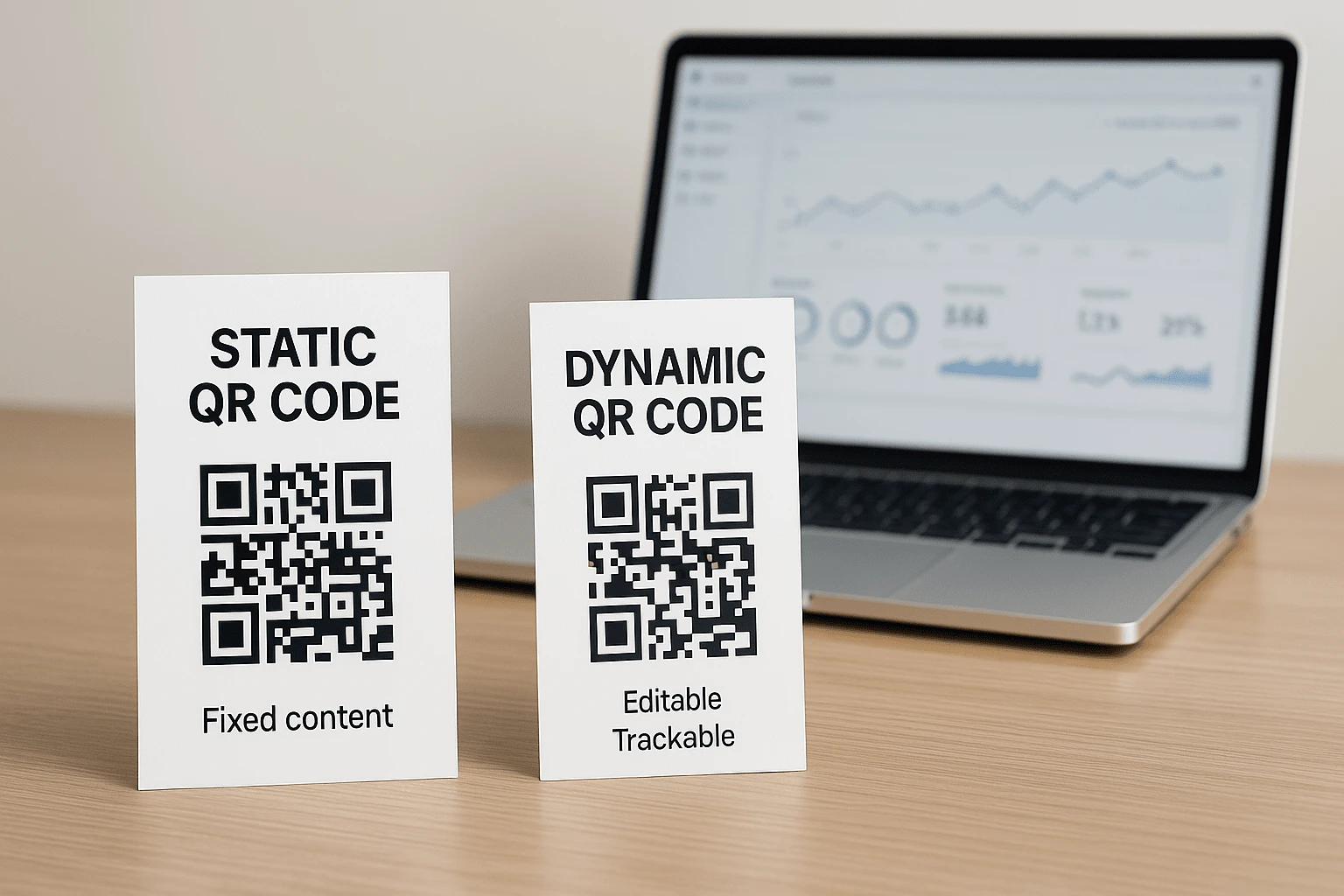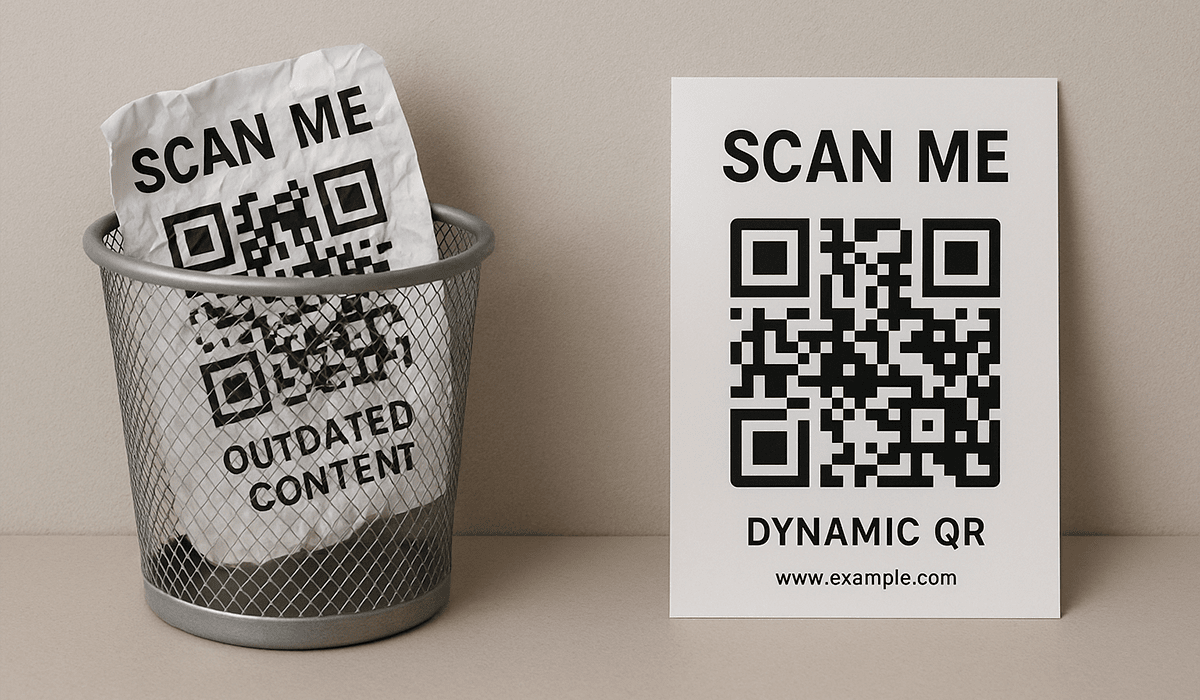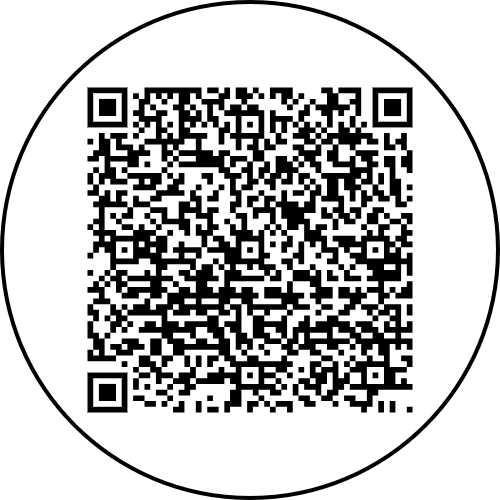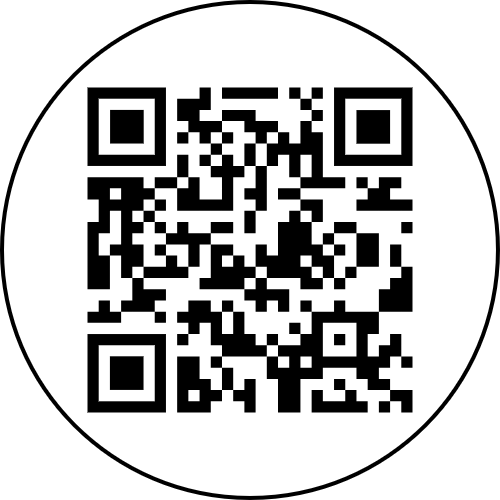
Static or Dynamic QR Code: What to Choose and What's the Difference?
QR codes have already become a part of our digital landscape. They're on cafe menus, product stickers, advertising campaigns, and even receipts. We’re so used to them that we don’t even think about how they work — we just scan them.
But as soon as you want to create your own QR code, the question immediately arises: which one to choose — static or dynamic?
At first glance, the difference might seem small. But it’s fundamental. The type of code you choose determines your flexibility, ability to make changes, access to analytics, stability, scan convenience, and sometimes even your budget.
This article will help you understand what makes them different, the pros and cons of each format, and most importantly — which option is right for you. No technical jargon, just examples, cases, and practical tips.
💬 If you're an entrepreneur, designer, marketer, or simply looking for an easy way to share information — this article is for you.
What is a Static QR Code — Simple, but Permanent
A static QR code is like an engraving in stone. The moment you create it, all the information is encoded directly in the graphic itself. It can be a URL, text, Wi-Fi password, or something else. But from that moment on, any changes are impossible. Want to update the link? You’ll have to create a new code and replace it everywhere — on printed materials, packaging, stands.
For many, this isn’t an issue. Static codes are suitable when information doesn’t change: Wi-Fi in a hotel, a link to a PDF manual, a feedback email. It’s simple, clear, stable. And most importantly — free and no registration needed.
It's an excellent option for those who want to create a QR code with text or quickly connect to Wi-Fi without any extra steps.
🟦 Benefits That Work for You
Static QR codes don’t require an account or internet access. You simply enter the data and get a code. No limits on the number of scans. No expiration date. And all of this — absolutely free.
Another benefit is offline functionality. For example, if you encode an email or Wi-Fi password, the user can access this data without an internet connection. This is especially useful at exhibitions, mountain hotels, or field events.
🔻 But There Are Some Nuances
As soon as you print such a code, you won’t be able to change anything in it. Neither the address nor the text can be edited. This means that in case of a mistake or link update, you’ll have to redo everything. And if you’re talking about a batch of 10,000 flyers — it gets expensive.
One more important point — there’s no analytics. You won’t know how many people scanned the code, when, or from which devices or countries. If you need to measure effectiveness, you should switch to dynamic solutions (more on that later).
By the way, if you plan to use long URLs with UTM tags — be careful. The static code will be dense and harder to scan, especially if the print quality isn’t perfect.
What is a Dynamic QR Code — A Code That Adapts
Imagine a QR code that's alive. Today it leads to one page, tomorrow—to another. And the code itself doesn't change. You don't need to reissue flyers, update stickers, or redo packaging design. This is exactly what a dynamic QR code is—a flexible solution highly valued by marketers, business owners, and campaign organizers.
Unlike a static code, a dynamic QR doesn’t encode all information directly. It contains a short redirect link (e.g., fbfast.io/q/abc123) that leads to whatever you set in your account. Today—to a promo, tomorrow—to a landing page, the day after—to a Google Form. Simple? Very.
You can create such a code in our QR code generator if you activate an account. This enables full analytics, password protection, campaign planning, and much more.
⚙️ The Advantages People Choose It For
1. Ability to Change. Changed the URL? No problem—just edit the address in your dashboard. The code stays the same. This is essential when printing has already been done, but the landing page has changed.
2. Full Analytics. You get statistics—how many times it was scanned, when, from which countries, on which devices. This is a real find for anyone who wants to track QR code effectiveness or run A/B tests.
3. Security and Control. You can set a password, restrict access by time or age, or set a scan limit. This is relevant if you work with private or paid content.
4. Versatility in Design. Dynamic codes are compact as they use a short link, so they look simpler, less "busy," and are easy to scan even with challenging print conditions or on screens.
📌 Case: A company runs a weekly promo. Instead of reprinting posters, they only change the URL in their account. The QR code stays the same, and the information is always up to date.
🔸 Are There Any Cons?
Yes, a dynamic code has some specifics. First, it requires internet—the user can’t access the link offline. Second, you need an account to create it (so you can manage the code).
But in exchange, you get full control, flexibility, and analytics. If efficiency, updatability, and strategic use matter to you—a dynamic code will be your go-to tool.
Security: How a QR Code Can Help—or Harm
A QR code isn’t just a handy “thing” for following a link. It’s also a data transmission channel. Depending on the type, it can be fully open or controlled. This is where another big advantage of the dynamic QR code comes in.
You can set access for selected users only—by password, by timer (e.g., only during a promotion), limit the number of views, or even set conditional logic (e.g., open different pages during day or night).
🔐 When Security Really Matters
- 📄 Private documents — access to a CV, contract, or internal company instructions.
- 💸 Promo codes or limited offers — to prevent abuse, you can limit the number of scans.
- 🔞 Age-restricted content — set up a warning message before redirecting.
- 📅 Events — temporary access to materials available only on the event day.
A static code doesn’t allow this—everything is “hard-coded” forever. Meanwhile, a dynamic code allows you to create a flexible access system that protects your data, your clients—and your reputation.
🔒 Fact: Static QR codes are used more often in phishing attacks due to the lack of control and analytics. With dynamic codes, you can restrict access, change the target, and quickly respond to risks.
More on this in our article “Are QR Codes Safe? How to Avoid Scams and Phishing”.
Static vs Dynamic QR Code Comparison — What’s the Real Difference?
If you’re still unsure which QR code suits you best—this section is for you. We’ve gathered the key differences in a handy table, and explained why each feature matters below.
| Criterion | 📘 Static QR | ⚙️ Dynamic QR |
|---|---|---|
| Can you change the content after creation? | 🚫 No | ✅ Yes, anytime |
| Scan analytics | 🚫 None | ✅ Full statistics |
| Access without internet | ✅ Yes (if it's plain text/Wi-Fi) | 🚫 No, internet required |
| No account required | ✅ Not needed | 🚫 Registration required |
| Ability to set restrictions (password, time, number) | 🚫 No | ✅ Yes |
| Scan convenience (especially with long URLs) | ❌ May be hard to read | ✅ Short link – easy to scan |
🧠 What It Means in Practice
Imagine you launched a print flyer campaign featuring a QR code. A week later the URL changes or a new landing goes live. If you have a static code—you’ll have to reprint everything. If it's dynamic—just update the address in your profile and all flyers remain up to date.
Likewise with analytics. If you want to know how many people scanned the code, from which countries, at what time, or from a mobile device—you won't get this with a static QR. And that’s critical for marketing where analytics matter.
But you may not always need this flexibility. If you’re simply printing a code with a Wi-Fi password or a single-page guide—why complicate things? In such cases, a static QR code does the job perfectly.
💡 Tip: Focus not just on features, but also the scenario. Sometimes, simplicity is the best choice.
How Business Costs Change: Hidden Expenses
At first glance, static QR codes seem more cost-effective — they are free, require no registration, and can be generated in a minute. However, if you work with printed materials or launch campaigns for your business, the picture may change.
Imagine you print 5,000 flyers with a QR code for a promotion. A week later, the offer changes — or you simply made a mistake in the link. A static code cannot be corrected. You will have to:
- 💸 overpay for a new print run,
- ⏱ lose time on logistics,
- 🤦 lose customers who scanned an outdated link.
Now, let’s compare this with a dynamic QR code. Even if it's a bit more expensive to create or requires an account, you can simply change the address — and the entire print run remains valid. This is especially beneficial for:
- 📦 packaging that can’t be reissued every week,
- 📣 ad campaigns with changing links,
- 📍 physical media: signs, stickers, billboards.
As a result, what seemed “cheap” turns out to be more expensive — not because of the code creation, but due to the lack of flexibility. A dynamic code isn’t an expense, but rather an insurance against losses.

When to Choose Which QR Code: Real-Life Examples
Theory is good, but context is vital. It all depends on what exactly you want to achieve. One code is perfect for printed business cards; another is indispensable in ad campaigns with analytics. Let’s look at some scenarios to make the choice clearer.
📘 When to Use a Static QR Code
Organizing an event in an offline space with unstable internet? For example, in a village club or a building without mobile coverage. In such cases, static codes work better — they can contain text, a Wi-Fi password, or contact details and don’t require a connection.
Another example — a business card. If you just want to encode an email, phone, or name, you don’t need complex scenarios. You can easily generate a QR code for a vCard and print it on any surface.
Or, a case from an exhibition: visitors scan the code to download an instruction manual in PDF. Since this file doesn’t change, a static QR code is a simple, stable, and inexpensive solution.
⚙️ When a Dynamic QR Code Is the Only Right Choice
Imagine launching a social media promotion, where the page or landing link changes weekly — but the flyers are already printed. This is where a dynamic QR code comes into play: you just update the URL and the code leads to the right place.
Or you want to track your campaign's effectiveness: how many scans, which devices, what time. This data helps you adapt your advertising and get better results. A static code won’t give you this information.
Another advantage is flexibility: password protection, age restrictions, scan limits, even browser language redirects. This is important for premium content, geographically targeted campaigns, or time-limited offers.
🔄 Summary: if you just need something basic — choose static. If you want to manage, track, update — you need dynamic.
The Same Content — Two Approaches: A Visual Demo
What looks identical on the outside can be completely different on the inside. Check out the two examples below — both codes lead to the same page. But only one of them can be changed, analyzed, or adapted to new conditions.
📘 Static QR Code
In this case, the link (including UTM tags) is embedded directly in the code. It cannot be changed — it’s “frozen.” If your landing page changes, you can’t update this information. And you won’t get any data about the number of scans.

⚙️ Dynamic QR Code
Here it’s the same URL — but only a short redirect is encoded. You can change the address even after printing. Plus, the system will gather scan analytics: from which countries, when, how many times, and from which devices.

This option is especially convenient if you want to create a custom branded QR code with design and logo — you can use the same code for multiple campaigns, changing only the target page.
💡 Fact: Over 80% of our users who tested both options eventually switch to dynamic QR codes.
What Can Go Wrong: Common QR Code Mistakes
In practice, QR codes are often perceived as something “simple”: generate, print, use. But it’s precisely this simplicity that hides the most common mistakes — which cost time, money, and reputation. Especially when it comes to marketing, mass printing, or product presentations.
🚫 The Most Frequent Fails with Static QR Codes:
- 🔗 Embedded URL with an error — once printed, it’s too late to spot a mistake in the link and the code becomes invalid.
- 📄 Outdated content — the link takes the user to a page or file that is no longer relevant or has been deleted.
- 🧱 Code that’s “too heavy” — a long URL with UTM tags creates a visually dense code that is hard to scan, especially with poor printing quality.
⚠️ Typical Mistakes with Dynamic QR Codes:
- 🛑 Forgotten redirect — the code is created, but the link hasn’t been set up. Users end up on a blank or technical page.
- 🗓 No expiration date — after the campaign is over, the code stays active and leads to outdated content (or a 404 error).
- 🔐 No protection for private data — no password was added, and internal information becomes accessible to anyone.
Important: the type of QR code itself is not a “mistake”. Problems arise when the choice does not match the scenario, or when the code is used without attention to detail. That's why it’s important to work with a reliable tool that not only creates but also allows you to manage your QR codes.
💡 Tip: always test your QR code on several devices before printing and add supporting text so users know what to expect after scanning.
For a deeper breakdown of mistakes, we also recommend reading: "The Most Common Mistakes When Creating QR Codes" and "The Most Common Mistakes When Using QR Codes".
Conclusion: There Is No Universal Option — Only Your Scenario
If you’ve made it this far, you now know more about QR codes than 90% of users. But the main point here isn’t technical theory. It’s understanding one simple principle: the choice between a static and dynamic QR code depends on the task you want to accomplish.
Need simplicity, offline access, or one-time use? A static QR code does the job perfectly. No accounts, no complexity — just generate and print.
Want to analyze, test, modify, or scale your campaign? A dynamic QR code gives you these tools. It’s no longer just a “code,” but a marketing asset with data, flexibility, and long-term potential.
And best of all — you don’t have to choose forever. You can test both options, compare their effectiveness, and see what works in your specific case.